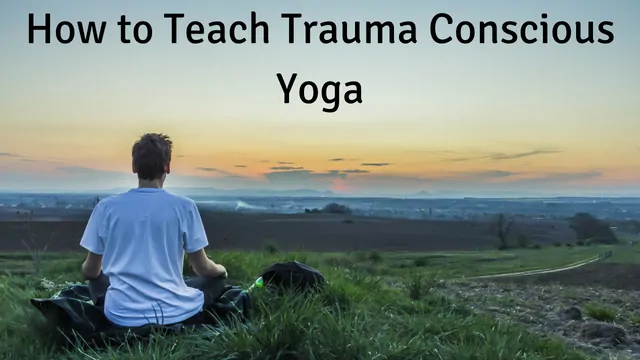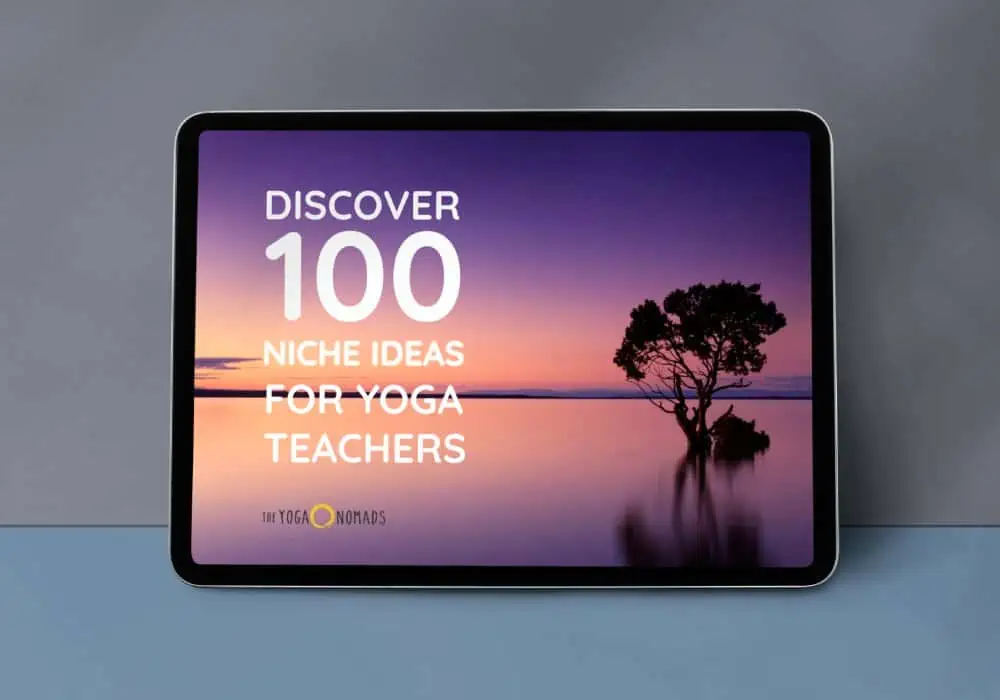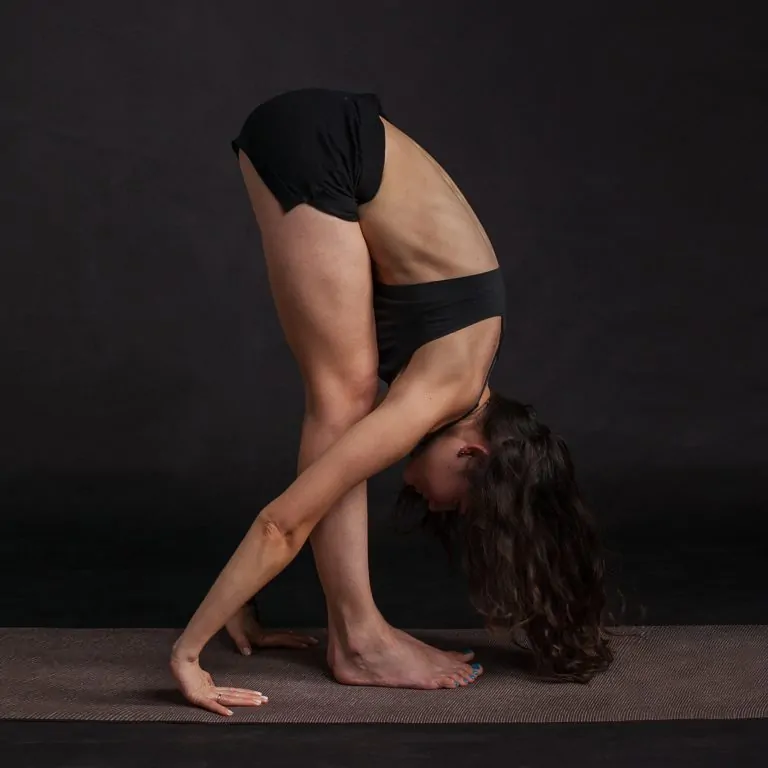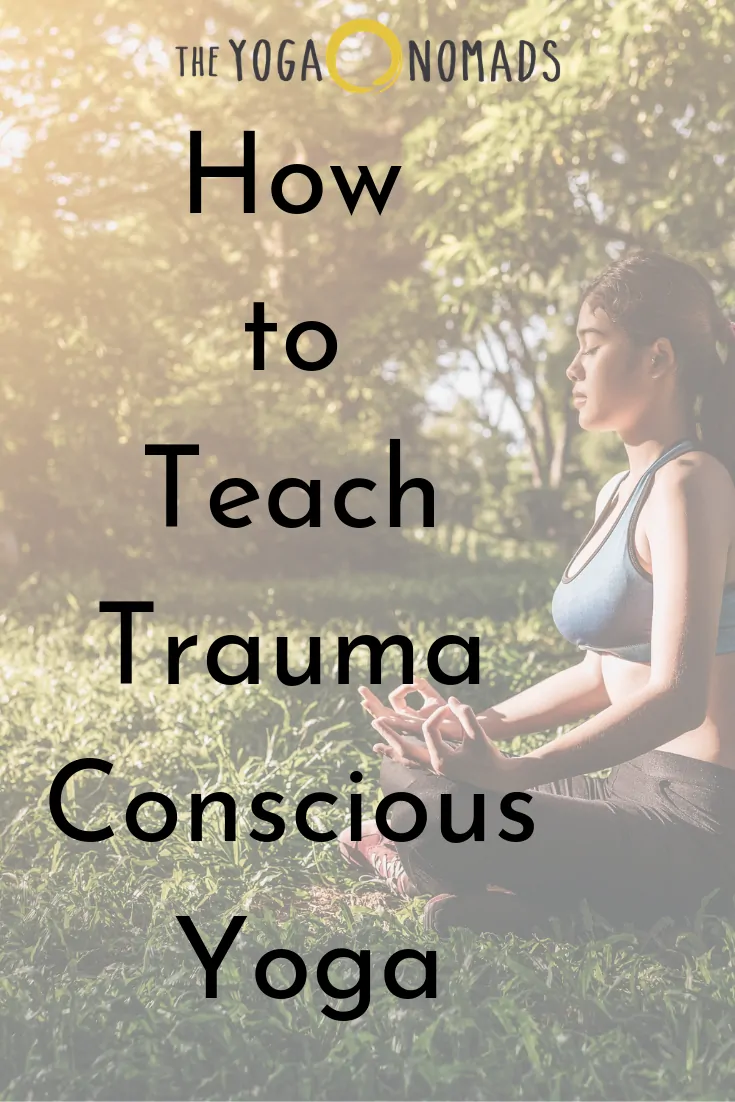We all have trauma, even if we haven’t experienced something we might traditionally think of as trauma such as an indecent assault. We all collect trauma from the time we’re very young: every time we were made to feel small, every time we were told that we’re unworthy, every time we felt like we had to shrink ourselves to be loved and accepted.
Contents
- 1 1. Avoid Command Language
- 2 2. Treat each pose as an invitation
- 3 3. Not using hands-on assists
- 4
- 5 4. Create a focus on the breath and how poses feel
- 6 5. Invite students to practice non-judgment
- 7 6. Do poses with the class
- 8 7. Never doing the deepest version of the pose
- 9 A Trauma Conscious Yoga Method Is Important
- 10 Trauma Sensitive Yoga Training and Self Learning
- 11 PS: Did you enjoy this article? Pin me!
It’s important to be aware that trauma is not unusual in people’s lives. About 80 percent of the population has experienced a trauma at one or another point in their life, through accidents, alcohol, depression, family violence, or other circumstances or events. It’s very useful for yoga teachers to become aware of the implications of what they say and do, and the speed and the intensity of their methods and the effect it might have on people. Learning to own your body can be a terrifying thing. –Bessel van der Kolk, MD
This is why it’s so important to incorporate trauma consciousness into every yoga class, regardless of what style of yoga you teach.
Trauma conscious yoga, also called “trauma informed yoga,” is about creating safe, non-judgmental spaces for healing and questioning how we are creating hierarchy in the space. How are we letting our ego influence the classes we teach and the way we teach them?
Teaching yoga for trauma requires a surrendering of what we think we know, an openness to allow students to have their own experience of the practice, and a willingness to hold a deep container for your students’ healing.
If we let it, trauma conscious yoga can bring each student back inside, back to their heart. This practice can be a teacher for us and for our students because when we hold non-judgmental space for students to heal, we hold that same space for ourselves, too.
If you finish this article and you still want to learn more, we list a few trauma informed yoga teacher training and self study options below 🙂
Let’s get started, scroll down to read 7 tips for teaching trauma conscious yoga.
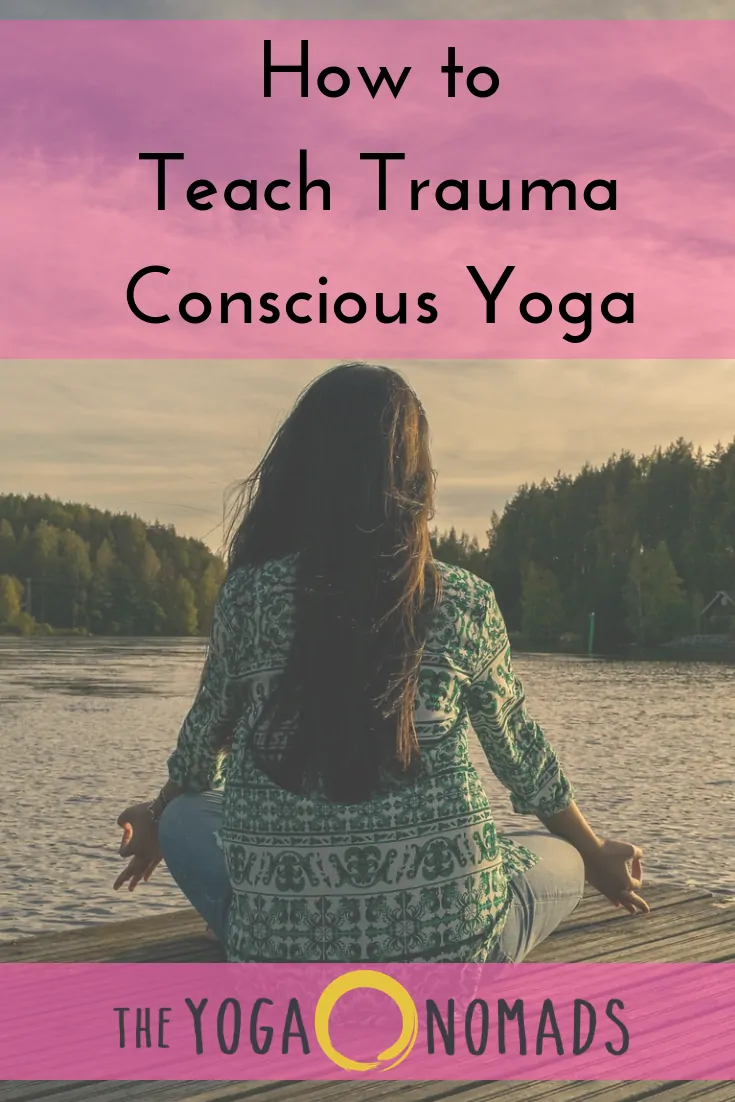

Pin me first? Then keep reading!
1. Avoid Command Language
This is a small shift that makes a huge difference. The vast majority of yoga classes we go to are taught with command language, meaning you might hear language telling you what to do like:
“Lift your leg.”
“Step back.”
“Lower your hips.”
“Breathe into your belly.”
Non-command language can be expressed as “we” or “-ing” language. Reframing the phrases above, that could look like:
“Lifting your leg.”
“Stepping back.”
“As we lower our hips.”
Free download: 100 Niche Ideas for Yoga Teachers
Download now“Breathing into the belly.”
Many yoga trainings teach that it’s important to use command language to establish your authority and expertise, so there’s definitely a bit of unlearning that goes along with this. If you were taught this as well, I invite you to ask yourself:
Why do students need to see me as an authority? Can I be less concerned about my students listening to me and more concerned about them listening to their own bodies?
Isn’t that the whole point of yoga– not how well you can follow instructions, but how present you can be? How deeply you can listen to your intuition and your body? How you can give yourself what you need?
Trauma yoga focuses on empowering students to do all of the above.
2. Treat each pose as an invitation
This goes along with using non-command language and is all about inviting students into a pose rather than telling students to do something. Instead of sticking to a rigid trauma sensitive yoga sequence, think of each pose as an invitation that a student can choose to step into or not. As teachers, we create a safe space when we make that clear to them while using trauma informed language.
This can look like presenting yourself as a guide, rather than an expert or authority, offering students options that they may or may not like to try. For example:
“You might like to reach your arm around your back and take a bind here, or maybe you stay as you are.”
Free download: 25 Ways Yoga Teachers can Earn More Money
Download now“Maybe you find a little movement here, or maybe you find stillness.”
“Maybe you’d like to shift forward into a plank and move through a vinyasa to clear out stuck energy, or maybe you’d like to stay in down dog for more grounding energy.”
“Feeling free to explore some more intuitive movement here, maybe starting to circle the hips, open up through the sides of the body, or finding a child’s pose.”
Often, the language that I use is “might” or “maybe,” but any way you’d like to phrase your sequencing that makes it clear to students that they are free to listen to their own bodies and that there is no right or wrong way to experience a pose will work.
The authors of an International Journal of Yoga Therapy report on trauma-sensitive yoga wrote, “We realized much of the language used by Yoga teachers involves the teachers trying to get students to do something, to push a little farther, or to try a little harder. We decided that trauma-sensitive Yoga was not so much about getting students to do something but more about inviting them to try something.”
If you’re worried about being too wordy or talking too much, take it slow! As you practice speaking this way more, it will become more intuitive and you’ll be able to find a balance that feels right for you.
When we offer gentle suggestions and options, we remind students that their yoga practice is theirs. Their body and breath are theirs, and what they need is going to shift depending on the day and the moment. In trauma conscious yoga, it’s important to never make students feel like they need to be anything else than what they are right now.
*Additional reading: 5 Ways to Improve Your Teaching Skills as a Yoga Teacher
Free Course: Create a Yoga Website You'll Love
(7 steps)
Enroll for Free
3. Not using hands-on assists
You can hold space for your students without touching them. You can create a deep, meaningful experience for your students without pushing them into a variation of a pose they didn’t ask for. Holding space in this way is validating and encourages them to trust their own intuition and their own body.
If you do choose to do assists, I invite you to do them verbally rather than hands-on. This could mean that you walk up to a student and say something like, “It might be more comfortable for you to step your left leg forward an inch or two” or “You might like to widen the space between your legs if you’re feeling pressure in your low back.”
Not doing hands-on assists is, again, something that goes against what most of us have been taught as yoga teachers. I remember one of my earliest teachers saying, “Everyone who comes to your class needs to get hands-on touch from you.”
But now, after a few years of studying and teaching, I respectfully disagree. However, if you do choose to do hands-on assists, they should always be consented to before class with the clear disclaimer that if you’re assisting someone and they change their mind, it’s absolutely okay to say no.
4. Create a focus on the breath and how poses feel
Trauma conscious yoga never focuses on how poses look. Often, we set an individual intention at the beginning of class for how we want to feel (such as present, creative, powerful, connected, in flow, safe, supported, etc.) and work to cultivate that on the mat.
In every pose, there is an invitation to bring your awareness back to your breath and to breathe deeply into your belly.
There is a reminder to never go into a pose deeper than your breath wants to take you– meaning that whenever the breath starts to feel shallow, stuck, or otherwise anything less than deep, full, and smooth, we back off. We set ego aside. We come back to the breath.
There is an invitation to make subtle adjustments based on how you feel. What would make you feel more powerful, present, creative, or supported? Is it taking child’s pose instead of a lunge? Is it connecting with the strength in your back leg in Warrior 2? Is it finding sway in your squat instead of stillness? Give your students permission to find whatever it is for them.
Learn to Create a Website for Your Yoga Business
Enroll for Free5. Invite students to practice non-judgment
Personally, this is an offering I give with my voice. I try to always make it clear literally and not just energetically that this is a space where it is safe to just be, often saying something like this as I open class:
“Reminding yourself that it is safe to be fully present in this space. Remembering that your practice is your own, that you are different every single day and that there is no need to push or force. I invite you to be present with the truth of your experience, to let your breath be your guide, to be fully present with your discomfort, with your body, with your emotions, your thoughts, your breath.
If you are wobbling in tree pose today, can you allow that to be true for you today instead of fighting it? That’s beautiful, breathe into it– it says nothing about you (that you’re not a real yogi, that you aren’t as “good” as everyone else,” that you’re a beginner, whatever else our ego likes to tell us). If you need grounding and nourishing, can you lovingly take a child’s pose instead of down dog? Again, it says nothing about you.”
It’s a beautiful thing to be able to hold space for students to honor the truth of their experience. There aren’t many spaces in life where we feel supported to be exactly who we are. No editing, no changing needed.
You don’t need to use my words, but you can invite your students to practice non-judgment of themselves and reassure them that no one is judging them, either, in whatever way you like.
6. Do poses with the class
Most of us are taught that the more advanced teachers walk around the class and don’t do most of the poses along with the students. In trauma conscious yoga, it’s important to show your students that you’re in this with them.
When we walk around the class instead of doing poses with students, we enforce a hierarchy, a separation between us and them, however subtle it may be. Students may feel watched or judged, and it’s important to not make them feel that way.
Typically, I will only walk around the class if I have something to share that I can’t share while doing a pose with them (like in half moon– I cannot talk when I’m in half moon!).
7. Never doing the deepest version of the pose
When you are doing poses with your class, it’s important to not hold the deepest version of the pose. You might demonstrate, for example, a full bind so that anyone who wants to try it can see how to do it, but then it’s important to drop back into the most gentle, or as I like to think of it “default,” version of the pose.
In trauma conscious yoga, we never want to create any type of “ideal” to aspire to. As teachers, we (hopefully) aren’t there to show off or stroke our own egos. Simply the fact that you are the teacher means that when you are in the gentlest version of a pose, it gives everyone else permission to be there, too. If students want to go deeper and that’s what their bodies need, we can absolutely welcome that. But making the gentlest version of a pose the default carries through this thread I’ve been talking about of non-judgment and of not pushing your practice into a mold it doesn’t want to fit into.
A Trauma Conscious Yoga Method Is Important
This article shares the story of Missy, a woman who was introduced to yoga at age 13 through a trauma-sensitive yoga program at a juvenile detention center. She talks about how this style of yoga helped her get some of her power back. She talks about how it gave her choices and made her feel normal.
Her story isn’t unique. We all want to feel like we have choices. We all want to feel normal, safe and supported. We all want to feel like we have a say.
To me, trauma conscious yoga is a lot about leaning more into yin, gentle energy, regardless of whether you teach a restorative class, a hatha class, or a flow class. Most of us spend many of our days in more yang, active energy, meaning we’re busy pushing, going, and doing (which is definitely still needed). But if we can let our yoga practice be a soft, loving expression of nourishing, healing energy and a practice of presence and breath, rather than using it to lead our students into specific shapes and cultivating an unsatisfied energy chasing the next thing, we can create a deep container for healing.
You may not incorporate all of these methods into your classes. But I invite you to ask yourself how you can create a more non-judgmental, healing space for your students to have their own experience and cultivate deep listening to their own bodies.
Trauma Sensitive Yoga Training and Self Learning
Trauma sensitive yoga training opportunities are growing over time, here are a few options you can consider:
- TraumaSensitiveYoga.com has a few yoga for trauma training programs in person and online
- Kripalu has an introductory trauma yoga training course
- Even Yoga Fit has a 100hr certification called the Warrior Program
- Jen Stuart runs a Yoga for Trauma facebook group which is a great place to learn
If you’d like to learn more about trauma conscious yoga on your own terms, I recommend checking out Liberation Prison Yoga’s trauma informed yoga training or reading the book The Body Keeps the Score: Brain, Mind, and Body in the Healing of Trauma.
Lastly, if you’re just getting started, attending some trauma sensitive yoga classes in your city would be a great way to dip your toes in the water 🙂
Comment below and share your thoughts about yoga and trauma!
Is teaching trauma conscious yoga important to you? What do you incorporate into your classes to make sure they are safe and healing for all students?

